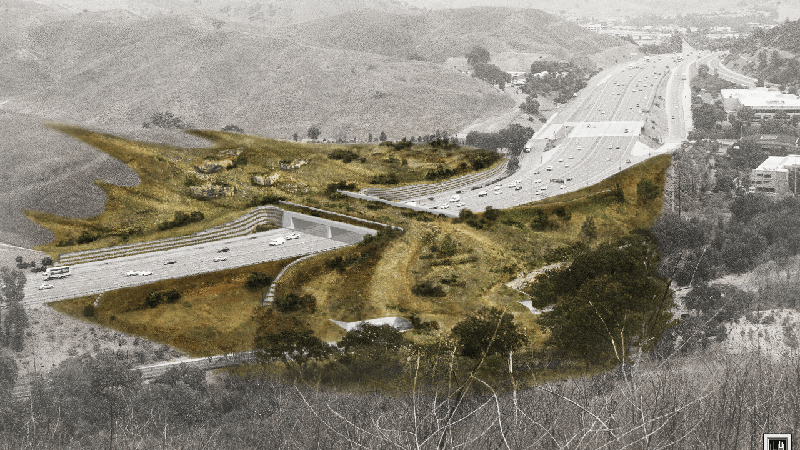The Wallis Annenberg Wildlife Crossing will help pumas and other critters in the Santa Monica Mountains cross 10 lanes of Highway 101.

Artist's rendering of the Wallis Annenberg Wildlife Crossing, which will be the largest in the world. Courtesy Living Habitats LLC
BY DEAN KUIPERS, Red Canary Collective
Former State Senator Fran Pavley is hiking in the blazing sun through a section of the dry-grass canyon along Highway 101 in Agoura Hills, talking about this radical moment. The last remnants of the mustard bloom spread over the low mountains, a gorgeous stretch of uninterrupted open space that would connect the Santa Susana Mountains to the north of Simi Valley all the way through this spot at the Liberty Canyon exit and southward into Malibu Creek State Park. Would, that is, if not for the 10-shrieking-lane barrier that is the 101 Freeway.
That barrier, though, is about to be bridged.
Only a few days earlier, on April 22, Pavley helped break ground for the Wallis Annenberg Wildlife Crossing, which will vault over the deadly highway and allow deer, coyotes, roadrunners and mountain lions to cross the freeway unharmed by vehicles.
The Wildlife Crossing is an ordinary, human-built thing: a bridge. But this bridge marks the humbling moment when we, Americans, took a significant step toward a new phase of co-existence with the more-than-human world — a phase in which we finally go all-out to do what is right for what Aldo Leopold called “the land community.” And because this effort is all-out, it will be the largest and most biologically complex wildlife crossing in the world.
“I have had mountain lions in my backyard,” says Pavley, who was Agoura Hills’ first mayor and has lived in the Hills since before the town was incorporated. “Bobcats, foxes, coyotes, deer, raccoons, possum [and] quail.”
For more than 40 years, she has worked tirelessly to preserve the huge tracts of parkland along the spine of the Santa Monica Mountains that are home to a rare urban population of pumas that — thanks to their superstar, Griffith Park’s mountain lion P-22 — are a global symbol of human-wildlife coexistence.
And when it became obvious, more than 10 years ago, that those pumas were suffering the effects of inbreeding as a result of the highway-made barrier from genetic diversity, Pavley worked toward a solution in her neighborhood: this bridge.
“Biologists figured all this out,” she says. “I don’t remember the concept of crossings and corridors and connectivity being normal words people use. Now, they’re understanding you can’t just have an island of open space.”
Indeed, the groundbreaking for this bridge marked the arrival of a more complex understanding of how wildlife and people share urban space. There was an almost giddy outpouring of joy and relief among the more than 40 dignitaries wrestling for the mic at the groundbreaking, including Governor Gavin Newsom, Wallis Annenberg and several U.S Congresspersons, though only Congressman Ted Lieu has the overpass in his district. After all, it took a ten-year campaign to get to this day. Many of us want to do something to stop species loss, curb climate change and give the foot-draggers a shove, but rarely do projects on this scale see completion.
We begin to reconnect the land and its wildlife, which never should have been fractured in the first place.
Corridors and connectivity are gaining champions. Rep. Adam Schiff, whose district is just to the east, has sponsored the Rim of the Valley Corridor Preservation Act (reference “The Most Amazing Park Expansion You’ve Never Heard About”), which would add a massive, 191,000-acre ring of urban-adjacent — and thickly connected — mountain and river spaces around the San Fernando Valley to the Santa Monica Mountains National Recreation Area. The Act passed the House last year. Senators Dianne Feinstein and Alex Padilla (both D-Calif.) subsequently introduced a companion bill to the Senate. If enacted, the expansion would join the wildlife overpass as critical pieces for reestablishing some of the region’s ecological integrity.
“Today we begin to reconnect the land and its wildlife, which never should have been fractured in the first place,” said Annenberg, who put up the $25 million challenge grant that anchored the $87 million project, at the Wildlife Crossing groundbreaking.
Do you see the radical nature of what’s being said? This is not the save-the-untrammeled-wilderness ethos of Muir and Roosevelt, in which we all take pride—this is a little more down-and-dirty. This bridge, like Schiff’s Rim of the Valley addition, is about granting a kind of equality to wildlife that lives amongst the Los Angeles metro area’s 13 million people. This is about building pumas and other creatures right into our dense city infrastructure — right into our lives.
And even though it took more ten years to make this crossing a reality, it’s only the beginning.
And that, dear reader, is just the beginning of this wonderful article. To read the rest of the story (for free, of course) find "The Bridge to Coexistence" on the Red Canary Collective.